One of the joys of traveling is getting to eat foods from all over the world. In my view, tasting local dishes, is one of the best ways to learn about a country and its people. And enjoying them with a local fosters a connection that automatically brings you closer. That was certainly the case when I traveled to West Africa and tried the top Ghanaian foods to eat in Ghana.

Ghanaian cuisine is built around starchy staples like fufu, kokonte, banku, and emotuo. They’re always served with a light soup or stew along with a protein. Common proteins include goat, beef, chicken, pork, lamb, snails, and fish. A number of ingredients are commonly used, including plain rice, tomatoes, plantains, peppers, black-eyed peas, onions, ginger, vegetable oil and palm oil.

Other popular dishes include the rice-and-bean based waakye; beef, pork, and goat kebabs; and bush meat. Bush meat consists of less common animal protein, including antelope and the large rodents called grasscutters. They tend to be favorites among the locals, though they tend to make tourists a bit squeamish. But true travel is all about getting out of your comfort zone and trying new things. I recommend doing just that—who knows, you may enjoy them like I did!

My incredible guides from Jolinaiko Eco Tours and I shared dozens of meals together. I tried so many foods that I knew I couldn’t list them all here. And I wanted to share them with you in this food guide. Ultimately, I settled on the twenty that made my mouth water and had me going back to them again and again. These are the top 20 Ghanaian foods you must eat in Ghana!

There are a few dishes I ate several times during my time in Ghana, and near the top of the list is fufu. A West African staple, fufu is a starchy, glutinous ball of dough made from boiled and pounded cassava and plantains. It usually comes with a soup or stew with a protein. It’s similar to a number of other dishes we’ll get into a bit later, but fufu is arguably the most well-known around the world.

My first time trying fufu was in Cape Coast, the historical city known for its famous slave castle. There, my guide Isaac and I headed to Emma Locals Chop Bar and got some fufu in a gingery, reddish soup with a big piece of goat and some tuna. The sticky fufu was the perfect complement to the hot, flavor-filled soup and was wonderful with both the gamy goat and briny tuna.
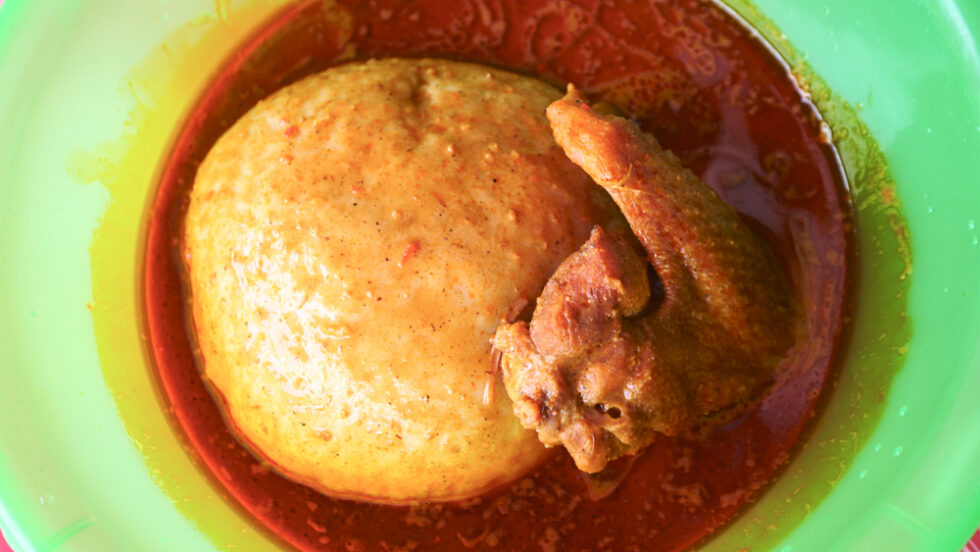
I tried fufu several more times as I made my way through the country, including in the city of Tamale near the end of my trip. There, the fufu came in an oily and mouthwatering peanut butter soup with chicken. I could not get enough of it!

The rich, velvety soup blew my mind, so much that I realized later that I was eating it incorrectly! Traditionally, small bits of fufu are eaten by themselves with the soup and swallowed whole without chewing. The meat is eaten separately. That said, it was so good that eating it incorrectly was still a flavor explosion in my mouth! It’s easily one of my favorite Ghanaian foods to eat in Ghana.

Another doughy dish you’ll find practically everywhere in Ghana is kenkey. This starchy food comes from the Ga and Fante people of West Africa and is made of a dough of ground and fermented corn. I tried it a number of times in my eleven days on the ground in the country, including in Accra and again at Lake Bosomtwe just south of Kumasi.

Like fufu, kenkey is meant to be eaten alongside a protein, usually fried fish or a meaty soup or stew. It’s also often eaten with a spicy hot black pepper sauce called shito. Both times I ate it, I had it with fried fish.

On the streets of Accra, I met a group of women making some in the famous Jamestown neighborhood. They worked fast, making seemingly hundreds of balls of kenkey per hour. It had a sour, fermented flavor that paired well with the small, crispy (and bony) fish served alongside it. The addition of shito gave the dish a nice kick of heat!

At Lake Bosomtwe, I met a woman along the lakeshore making a special variation called Fante kenkey. This type of kenkey comes specifically from the Fante or Fanti people in the central and western coastal regions of Ghana. She served it alongside fried tilapia and shito with fresh onions. The sour flavor of the kenkey, heat of the shito, acid of the onions, and briny fish balanced each other out well!

Arguably the most popular and one of the most widely available Ghanaian foods to eat in Ghana is waakye. I ate it more than any other dish during my time in Ghana and loved it every time! Traditionally a breakfast item, it contains black-eyed peas and rice. It may also include spaghetti, shito, egg, meat, and more.

The first waakye I tried in Ghana was at Buka Restaurant in Accra. This incredible restaurant has an open-air dining hall and a terrace. Their waakye came with spaghetti, cabbage, a tomato sauce containing goat meat, shito, chilies, egg, and garri.

The fatty goat meat was bursting with gamy, savory flavor, and the marrow in the bones was out of this world. When you add the crunchy gari to the flavorful rice and beans, spaghetti, stew, and shito, you get a wonderful texture explosion in your mouth that keeps your taste buds guessing!
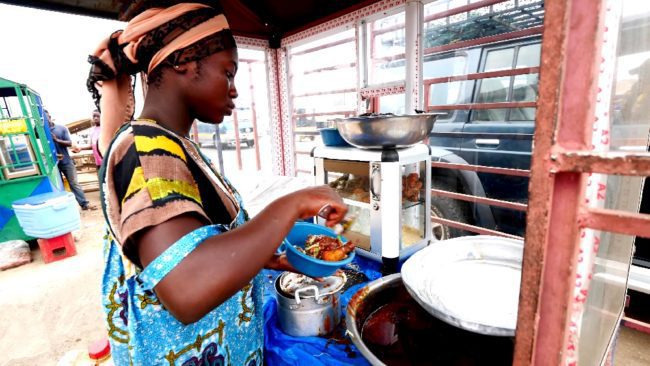
Another waakye I loved was the kind I enjoyed in the city of Tamale in northern Ghana. This waakye contained the customary rice and beans along with spaghetti, garri, beef, fish, a spicy black pepper sauce, and a hard-boiled egg.
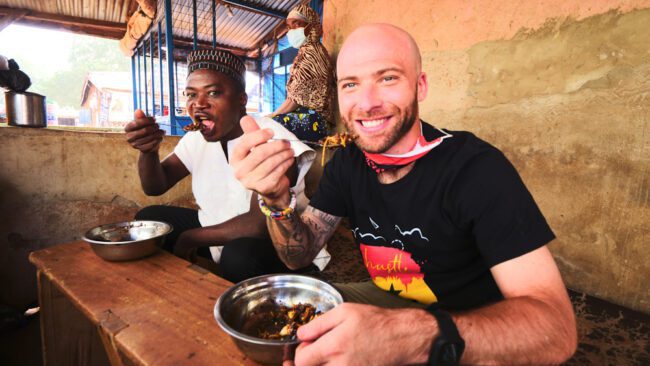
The fish added a saltiness and brininess, and the heat and addition of the noodles reminded me of some Asian dishes I’d had. The beef was tough, dry, and smoky, almost like beef jerkey, and the peppery sauce added some heat and bitterness. It balanced out all the other flavors and helped make this waakye one of my favorite rice bowls ever!will admit

I have a special place in my heart for banku and tilapia, the very first Ghanaian foods I had to eat after arriving in Ghana. Like kenkey, it contains fermented corn dough, but it also contains cassava dough as well. Like fufu and kenkey, it can be found throughout the country but is among the top Ghanaian dishes in Ghana, especially among the Ewe people of southern Ghana.

Also like kenkey, it’s often served with fish. Just moments after landing in Accra, my guide Isaac and I came across a vendor grilling tilapia and selling shito, vegetables, and banku on the side. Like other starchy foods in the country, you pinch off a small amount of banku and eat it with your hands.

The crispy, grilled fish was fantastic on its own, but adding the doughy banku and gingery and tomato-rich shito took it to another level. Shito can be very spicy—the one I had that first night was easily an 8/10 on the spice level—but the tomatoes, onions, carrots, and cabbage on the side helped temper the heat.

One of Ghana’s many bright and vibrant foods, red red is also a local favorite. It consists of black-eyed peas cooked in red palm oil, which gives the dish its name. Fried plantains are often served on the side. I tried this amazing dish at Asanka Local chop bar in Accra’s Osu neighborhood.

It came alongside grilled chicken, garri (crunchy cassava dough balls or flour), and plantains. The red red was especially flavorful despite it not containing many spices, and had a nice, creamy texture.

The starchy and oily beans paired extremely well with the sweet plantains, crunchy garri, and the savory chicken. The plantains reminded me of maduro, a popular plantain dish throughout Latin America. It’s among the top Ghanaian food you must eat in Ghana!
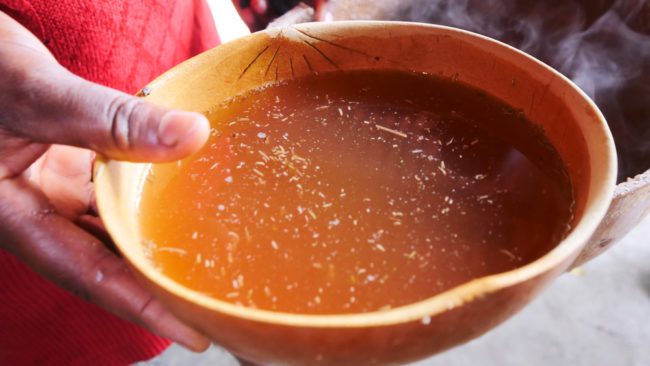
Nearly everywhere I’ve traveled around the world, I’ve come across people who make their own alcohol at home. Whether it’s home wine makers in Georgia, rakija makers in Albania, or pitorro distillers in Puerto Rico, people always find a way to make their favorite adult beverages.

One of my favorites in Ghana is a millet beer called pito. To try some, my guide Isaac took me to a small house in the Osu neighborhood in Accra. There, I watched them soak, dry, and germinate milled before boiling it in water. The end result is a yeasty, bitter, and strong drink that reminded me of a jungle beer I once tried in the village of Palumeu in Suriname.

The pito came in two varieties: a lighter, more bitter version and a darker, cloudier one that had a much sweeter flavor. I personally enjoyed the sweeter one more and was surprised to learn that it’s actually non-alcoholic!

A staple in northern Ghanaian cuisine, tuo zaafi is another dense and starchy dish served alongside meat and soups. Traditionally, tuo zaafi is made with either maize or millet flour and water. The end result is a thick, sticky, carb-rich paste that pairs perfectly with okra soup.

I enjoyed tuo zaafi at the tail end of my week-and-a-half in Ghana, at Northern Platter Restaurant in Accra. My friend Lotte from Ghana Food Movement and I enjoyed it with a tasty and viscous hibiscus sauce. There were also some fish and a vegetable stew on the side. The stew had the consistency of creamed spinach, and the fish contained a nice red palm oil.

The flavors were powerful even though the dishes themselves were quite light. They all balanced each other out well and honestly blew my mind. Tuo zaafi has to be on your top Ghanaian foods to try list when you travel to Ghana!
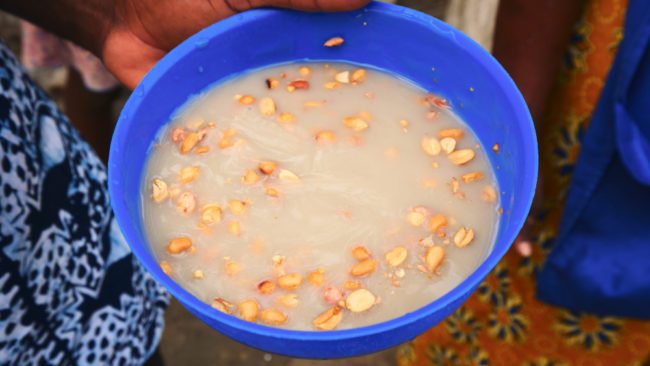
As I learned while traveling through Ghana, many of its carb-heavy dishes are humble and inexpensive. They’re designed to fill your belly while providing a decent amount of nutrition. Nowhere is that more prominent than in the porridges you can find throughout the country.

My first porridge in Ghana was a thick corn porridge I tried at Osu Night Market in Accra. This local favorite, akasa, costs just one cedi, or about $0.17 for a cup-sized baggie. I guessed it was fermented, as it had a slight bitter flavor along with a hint of sweetness. It was filling and coated my stomach, making it a great thing to have after eating spicy foods!

The other porridge I tried in Ghana was a millet porridge called hausa koko. I tried it a couple of times in the country. The second was a plain millet porridge I tried in a small, traditional hut village outside of Tamale. It was very bitter and honestly wasn’t my favorite, but I tried another, slightly different version in Accra that I enjoyed a lot more.

On my way to Makola Market, I came across a street vendor selling bowls of hausa koko with peanuts and a donut-hole-like snack called bofrot. The woman gives you the option of adding sugar to the porridge, which makes it a lot tastier, especially when combined with the nuttiness of the peanuts.
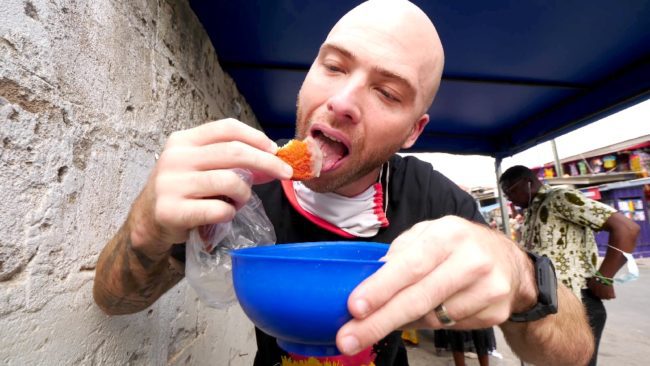
If you want to really immerse yourself in everyday Ghanaian life, porridges are among the top Ghanaian foods to try in Ghana!

During my time at the Golden Hill Parker Hotel in the city of Elmina, I enjoyed an incredible prawn curry you must try. This amazing accommodation that overlooks the city is home to Ocean View Restaurant, which boasts a warm and friendly staff and some of my favorite food in the country.

This electric prawn curry contained onions, green peppers, and carrots. The ingredients were fresh and full of intense flavor, and I loved the level of spice. It sort of reminded me of the green curries I ate during my time traveling Thailand! The curry came with a larger meal that consisted of okra stew, banku, yam fries, shito, fried prawns, and rice.

Ghanaian food is almost always seasoned to perfection using a combination of local spices and herbs. Many of them also have some real heat to them, and this curry was no exception. I love a lot of spice in my food and this prawn curry did not disappoint!

Another thing I was surprised to find in Ghana was a drink called akpeteshie. This drink, which consists of a blend of plants mixed with gin, has a strong, bitter, and medicinal flavor. It’s often used as a sort of digestive and accompanies a meal, as the bitter flavor stimulates your digestive system.

I first tried akpeteshie at Asanka Local Chop Bar in Accra. I don’t really love the strong juniper flavor of gin, but this akpeteshie also had an earthy, herbal flavor that I enjoyed quite a bit. There were also other varieties that were less bitter and had a more palatable aroma, so you may be able to find one you like!

I also tried some akpeteshie at a friend’s house in Accra. My friend Cindy, who runs Jolinaiko Eco Tours, offered me some made from fermented palm tree sap. Like the one I tried at the chop bar, it was extremely strong and herbal with a juniper-like flavor. It’s definitely an acquired taste, but as it’s a local favorite, it’s one of the top Ghanaian foods you must try in Ghana!

I will admit, during my time in Ghana, I tried so many sticky and doughy starch balls that, after a while, it became hard to distinguish them from one another. But one of my favorites was a dish called emotuo, which I ate at Tourist Spot Restaurant along the road from Elmina to Kakum National Park.

Emotuo, also known as omo tuo, is made up of broken pieces of rice, boiled in enough water to make it very soft. Then, they pound the rice into a glutinous, starchy paste, which is then shaped into a ball. It’s often eaten with groundnut/peanut soup or pounded palm nut soup.

I ate my emotou with a thick, rich peanut soup with antelope ribs! I’d never eaten antelope before, but the fatty and gamy flavor paired really well with the emotou. It reminded me of Japanese sticky rice and I personally enjoyed it more than the fufu and banku I’d tried earlier in my trip. But my favorite part was dunking bits of the emotuo into the silky peanut soup. I couldn’t get enough of it! It’s one of the best Ghanaian foods to eat in Ghana!

Another dish I thoroughly enjoyed during my time in Ghana is a delicacy called etor. This dish consists of boiled and mashed plantains with peanuts, shito, onions, eggs, chilies, avocado, palm oil, and black pepper. I enjoyed this dish only once during my trip, but it was so memorable, I had to include it.

I tried etor in the culturally-rich city of Kumasi, at its sprawling Kejetia Market. Within its labyrinthine expanses of vendors and tight lanes, you may find a group of women peeling plantains to build this amazing dish.

All of the ingredients were covered in a delicious peanut sauce that added a rich nuttiness to the crumbly plantains, smooth avocado, and tasty beef. The chilies and shito gave it a nice amount of heat that wasn’t overbearing. Overall, it’s easily one of my favorite Ghanaian foods you must eat in Ghana!

As a world traveler, I have learned to open my mind to dishes that are far from what I normally eat in my day-to-day life. That’s one of the joys of traveling—meeting new people, immersing yourself in new cultures, and trying unique foods you can’t find anywhere else! One of the most unique and extreme Ghanaian foods you can eat in Ghana was the giant African snail I ate in Kumasi.
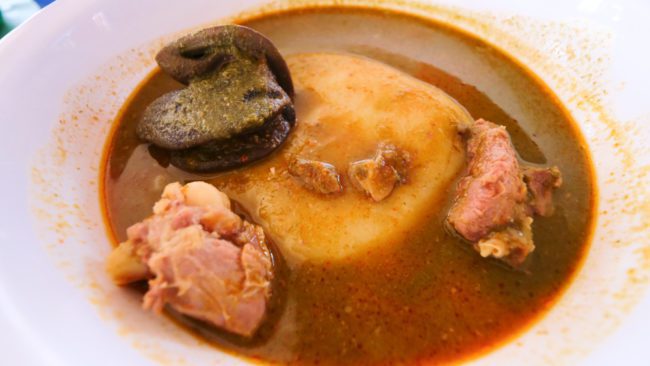
I’d been seeing giant African snails everywhere in Ghana—slithering across the tables at every market, and on the menu at several spots. But I got my first got the chance to try some at Ceci Chop Bar, along with some fufu, goat, and a delicious, peanut soup.
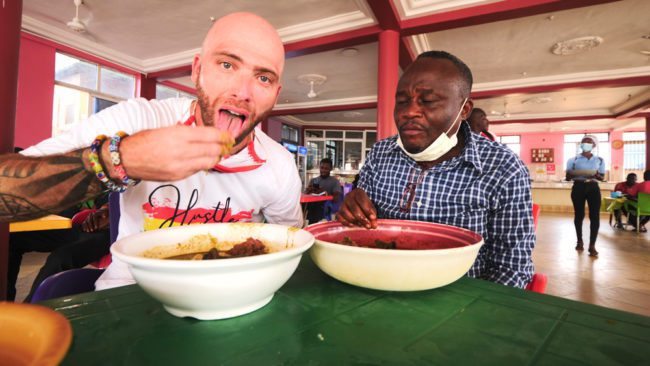
I’ve eaten small snails—escargot—before in Europe, but this snail is their larger, meatier, and gamier cousin. It was a genuine monster, with a unique and earthy flavor that worked well with the peanut soup and fufu. It’s so big that some people will likely be frightened by it, but don’t be! It’s actually delicious, flavorful, and a little spicy, as was a highlight of my trip through Ghana.

One of the most popular dishes you can find throughout West Africa is jollof rice, a dish that stems from what is now Senegal and the Gambia. It has a number of regional variations in other countries, including Nigeria, Mali, and yes, Ghana. It’s usually made with long-grain rice, onions, tomatoes, meat, and various spices.

The Ghanaian version of the dish contains bell pepper, onion, garlic, tomato paste, chilies, vegetables, rice, black pepper, and meat (usually beef, chicken, or goat). The meat is prepared first by seasoning it well and frying it, and then the remaining ingredients are fried together. Shito is usually served on the side.

I tried some delicious jollof rice at a roadside restaurant not far from Mole National Park. This jollof rice added cabbage to the usual ingredients and came with some crispy and tender fried chicken. The rice itself had a bright orange color and came with a wonderfully spicy shito. The cabbage added a nice crunch and freshness!

As my Ghanaian trip wound to a close back in Accra, I enjoyed a unique plant-based dinner at Tatale, a vegan restaurant in the capital. There, I tried several fantastic and flavorful dishes, including a West African favorite called egusi. I also tried it earlier in my trip in the village of Ahwiaa outside of Kumasi.

Egusi is a thick soup made with ground-up egusi seeds, palm oil, water, various greens, tomatoes, okra, meat, seafood, and spices. It has different names and variations depending on where you eat it, and is especially popular among the Yoruba and Igbo people of Nigeria.

The egusi was creamy, sweet, nutty, and phenomenally seasoned. It was also meat-free. The mix of melon seeds, palm oil, and spinach, in particular, had my taste buds dancing on my tongue. Although there are other dishes I ate more often there, the egusi was probably my favorite dish in all of Ghana! I honestly couldn’t get enough of it. I ate it with brown rice on the side, which made for a magnificent pairing. It’s a must if you’re looking for incredible Ghanaian foods to eat in Ghana!

While you’re at Tatale Restaurant in Accra, I suggest trying a few more items from their menu. Another of my favorites was the abolo, a type of corn mash from Ghana’s Volta Region. At Tatale, they serve it with black-eyed peas, zucchini, and okra.

It’s a very healthy and green dish, with a wonderful nuttiness from the corn. The crisp zucchini adds a refreshing feel and flavor, and the okra adds a thick consistency and a more herbal taste. While I’m definitely a carnivore, this was my kind of dish!

When I explored Osu Night Market in Accra with my guides Isaac and Nii Laaye, I was blown away by what I found. The market is over 420 years old and is a fantastic spot to grab a bite to eat after nightfall. One of my favorite things I found there was a dish called kelewele.

This dish is made up of cubed, deep-fried plantains that are coated in pepper and other spices. I recommend getting it fresh out of the fryer and letting it cool down for a few minutes. The kelewele has a soft consistency, similar to maduro. I loved the slightly crispy exterior, and nice, palatable texture. It was both sweet and savory, and heaven on my palate! A must for foodies exploring the best Ghanaian foods to eat in Ghana!

If you ever find yourself in Accra, Northern Platter Restaurant is a must if you’re looking for northern staples. You can try a number of unique dishes I didn’t eat anywhere else there. One of them is a type of dumpling called tubaani.
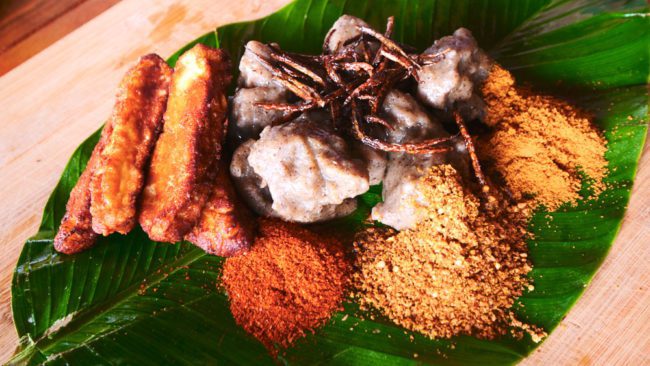
Tubaani is a millet dumpling that also contains black bean flour, salt, and water. They’re usually steamed, but this version was boiled. They came with another incredible dish called wagashi—more on that later—fried onions, and three dipping powders. The powders included chili powder, suya spice, and a spicy and fried peanut powder called kuli kuli.

The dumplings are chewy and savory, and the powders add new levels to the flavor profile. I enjoyed trying them separately, but mixing and matching them was my favorite thing about eating them! See which combination you like when you try these amazing Ghanaian foods you must eat in Ghana!

During my time exploring the craft villages outside of Kumasi, my guides and I stopped at a small restaurant, where I got my first taste of a dish called kokonte. Similar in many ways to fufu, banku, and emotuo, kokonte is a sticky, pasty, and starchy ball made from cassava flour. It’s common throughout West Africa, including Ghana and Togo.

The kokonte came in a bowl with a reddish-brown goat stew containing red palm oil. I learned that the dish’s color varies depending on where which ethnic group makes it. My guide Isaac also told me that the dish is sometimes referred to as “face the wall,” as it was once considered a low-class food. There was once a lot of shame in eating it.

The kokonte tasted almost identical to fufu, so much so that I couldn’t really distinguish the difference between the two. Like with the fufu, I enjoyed pinching off bits of the kokonte, dipping them in the stew, and eating them alongside the meaty goat. Just remember to wash your hands beforehand!
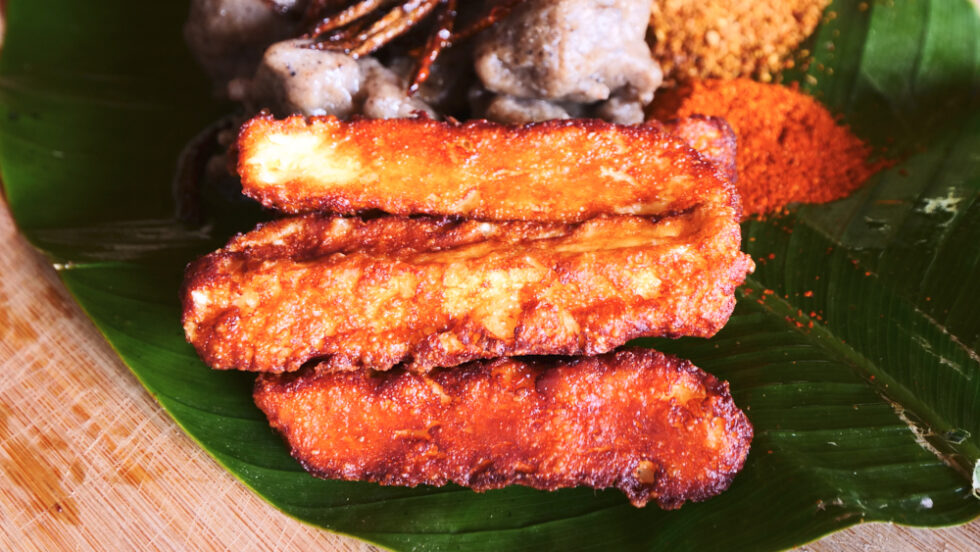
One of the more unique dishes I tried in Ghana is something you may not expect—a fried cheese dish called wagashi. In the eleven days I spent in the country, it’s the only dairy dish I came across!
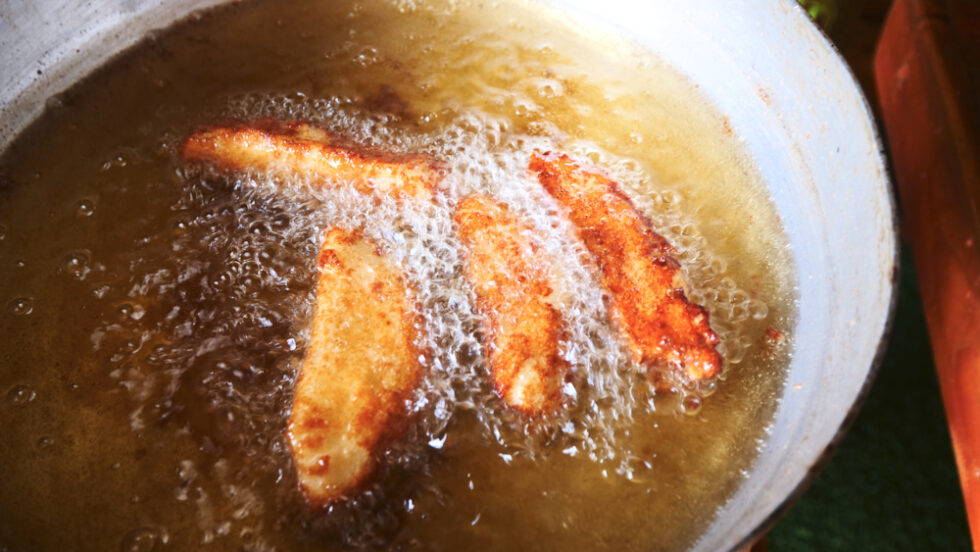
Wagashi consists of fresh cheese and stems from the Fulani, a nomadic tribe that lives in Ghana and Benin. I ate the wagashi alongside the tubaani and dipping powders, which was a magnificent combination. The slightly pungent dairy flavor was something I’d missed during my travels. And the light fry on the outside gave it just enough crispness. I wish I’d had more of it on my trip!

With so many mouthwatering dishes to choose from, I had a hard time narrowing my list down to just twenty. One I really enjoyed, but only ate once during my trip, was tatale. Tatale is a traditional pancake made from overly ripe plantains, cornmeal, onions, ginger, and peppers.

I tried this dish at its namesake, Tatale Restaurant in Accra. Their version of tatale is a bit different from the flat pancakes traditionally known as tatale. Instead, their modern, updated take on tatale shapes the plantains into rectangular blocks, elegantly stacked on top of one another. They’re both sweet and savory, soft like a cake, and very healthy tasting! If you’re looking for the top Ghanaian foods to eat in Ghana, this is one of them, without a doubt!

I thought I knew what to expect when I traveled to Ghana. But then I landed and everything I thought I knew went out the window. Ghanaian food, and West African food as a whole, is wonderfully diverse and bursting with flavor. Special care goes into adding contrasting textures and creating rich flavor profiles. It makes each meal an adventure for your taste buds. From the common to the more exotic, the food in Ghana is never boring. It’s something everyone should experience at least once. Book a trip to Ghana today to try my top 20 Ghanaian foods you must eat in Ghana!
NOTE: If you need to check the visa requirements of a particular country, click here. To apply for a visa, find up-to-date visa information for different countries, and calculate the cost of a particular visa, click here!
Counter
101 Countries • 1432 Cities